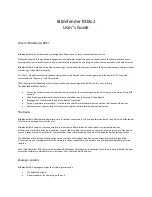
A.2 On-site Cable Assembly and Installation
This section describes how to assemble and install power cables, Ethernet cables, and other
cables.
A.2.1 Cable Assembly Precautions
Check the cables and connector components, choose appropriate cables and connector
components, and assemble them properly according to the cable assembly precautions.
Checking the Cables
l
If the jacket or insulation layer of a cable is visibly dirty, clean it before assembly.
l
If the jacket or insulation layer of a cable is visibly damaged or has any significant
defect, do not use the cable.
l
If the shield layer of a cable is visibly damaged, do not use the cable.
l
If the jacket or insulation layer of a cable crack after the cable is bent or twisted, check
whether other cables have the same problem. If other cables do not have this problem,
use one of them instead of the defective cable. If other cables have the same problem, do
not use any of the cables and obtain replacements.
Checking the Connectors
l
If a connector has any visible defect, damage, rust, or scuffing, do not use it.
l
If the pins or shells of a connector are damaged, do not use the connector.
l
If there is dirt on the pins or in the jacks of a connector or if there are conductors
between pins or between pins and the shell, do not use the connector.
Precautions for Assembly
l
Use dedicated tools or tools from Huawei and follow the assembly procedure.
l
When installing or removing cable components, handle the cable terminals instead of the
cables.
l
Take the following precautions when cutting or peeling cables:
–
After cutting cables, keep the extra lengths of cable.
–
After cutting cables, coil the cables that exceed 2 m. Bind and fasten the coils using
bundling ropes. Ensure that the inner diameter of the coils is at least 20 times
greater than the outer diameters of the cables.
–
When peeling the cable jackets, avoid damaging the shielding layers (braid or
aluminum foil), insulation layers, core conductors, and other jackets that do not
need to be peeled.
–
Clean sections of exposed jacket (for example, the dead ends of power cables). Cut
all cables flush.
–
Do not touch the core conductors of cables. Handle the conductor peeled from
cables quickly so that the conductor surface does not oxidize.
l
Take the following precautions when crimping and connecting cables or connectors:
–
Ensure that terminals and conductors are connected securely after they are crimped.
Do not move or bend them.
HUAWEI USG9500 Series
Hardware Guide
A Appendix
Issue 03 (2017-12-15)
Huawei Proprietary and Confidential
Copyright © Huawei Technologies Co., Ltd.
444














































